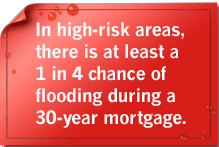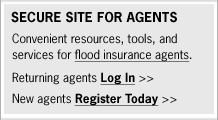
A B C D E F G H I J K L M N O P Q R S T U V W X Y Z
Act - The National Flood Insurance Act of 1968 and any amendments to it.
Actual Cash Value (ACV) - The cost to replace an insured item of property at the time of loss, less the value of physical depreciation.
Base Flood - The flood having a 1% chance of being equaled or exceeded in any given year.
Base Flood Elevation (BFE) - The elevation shown on the Flood Insurance Rate Map (FIRM) for Zones AE, AH, A1-A30, AR, AR/A, AR/AE, AR/A1-A30, AR/AH, AR/AO, V1-V30, and VE that indicates the water surface elevation resulting from a flood that has a 1% chance of equaling or exceeding that level in any given year.
Basement - Any area of the building, including any sunken room or sunken portion of a room, having its floor below ground level (subgrade) on all sides.
Breakaway wall - A wall that is not part of the structural support of the building and is intended through its design and construction to collapse under specific lateral loading forces, without causing damage to the elevated portion of the building or supporting foundation system.
Community - A political entity that has the authority to adopt and enforce floodplain ordinances for the area under its jurisdiction. In most cases, a community is an incorporated city, town, township, borough, village, or an unincorporated area of a county or parish. However, some states have statutory authorities that vary from this description.
Community Rating System (CRS) - A program developed by the FEMA Mitigation Division to provide incentives for those communities in the National Flood Insurance Program that have gone beyond the minimum floodplain management requirements to develop extra measures to provide protection from flooding.
Condominium - That form of ownership of real property in which each unit owner has an undivided interest in common elements.
Elevated Building - A building that has no basement and has its lowest elevated floor raised above the ground level by foundation walls, shear walls, posts, piers, pilings, or columns. Solid foundation perimeter walls are not an acceptable means of elevating buildings in V and VE zones.
Elevation Certificate - A certificate that verifies the elevation data of a structure on a given property relative to the ground level. The Elevation Certificate is used by local communities and builders to ensure compliance with local floodplain management ordinances and is also used by insurance agents and companies in the rating of flood insurance policies.
Emergency Program - The initial phase of a community's participation in the National Flood Insurance Program. During this phase, only limited amounts of insurance are available under the Act.
Enclosure - That portion of an elevated building below the lowest elevated floor that is either partially or fully shut-in by rigid walls.
Federal Emergency Management Agency (FEMA) - The federal agency within the Department of Homeland Security that is tasked with responding to, planning for, recovering from, and mitigating against man-made and natural disasters.
Federal Policy Fee - A flat charge that the policyholder must pay on each new or renewal policy to defray certain administrative expenses incurred in carrying out the National Flood Insurance Program.
Flood - A general and temporary condition of partial or complete inundation of two or more acres of normally dry land area or of two or more properties (at least one of which is the policyholder's property) from one of the following:
- Overflow of inland or tidal waters
- Unusual and rapid accumulation or runoff of surface waters from any source
- Mudflow
- Collapse or subsidence of land along the shore of a lake or similar body of water as a result of erosion or undermining caused by waves or currents of water exceeding anticipated cyclical levels that result in a flood as defined above
Flood Disaster Protection Act (FDPA) of 1973 - Made the purchase of flood insurance mandatory for the protection of property located in Special Flood Hazard Areas.
Flood Hazard Boundary Map (FHBM) - Official map of a community issued by the Federal Insurance Administrator, where the boundaries of the flood, mudflow, and related erosion areas having special hazards have been designated.
Flood Insurance Rate Map (FIRM) - Official map of a community on which the Mitigation Division Administrator has delineated both the special hazard areas and the risk premium zones applicable to the community.
Flood Zone (Zone) - A geographical area shown on a Flood Hazard Boundary Map or a Flood Insurance Rate Map that reflects the severity or type of flooding in the area.
Floodplain - Any land area susceptible to being inundated by floodwaters from any source.
Floodplain Management - The operation of an overall program of corrective and preventive measures for reducing flood damage, including but not limited to, emergency preparedness plans, flood control works, and floodplain management regulations.
Grandfathering - An exemption based on circumstances previously existing. Under the NFIP, buildings located in Emergency Program communities and Pre-Flood Insurance Rate Map buildings in the Regular Program are eligible for subsidized flood insurance rates. Post-Flood Insurance Rate Map buildings in the Regular Program built in compliance with the floodplain management regulations in effect at the start of construction will continue to have favorable rate treatment even though higher base flood elevations or more restrictive, greater risk zone designations result from Flood Insurance Rate Map revisions.
Group Flood Insurance Policy (GFIP) - Issued by the NFIP Direct Program in response to a presidential disaster declaration. Disaster assistance applicants, in exchange for a modest premium, receive a minimum amount of building and/or contents coverage for a 3-year policy period. An applicant may cancel the group policy at any time and secure a regular Standard Flood Insurance Policy through the NFIP.
Increased Cost of Compliance (ICC) - Coverage for expenses a property owner must incur, above and beyond the cost to repair the physical damage the structure actually sustained from a flooding event, to comply with mitigation requirements of state or local floodplain management ordinances or laws. Acceptable mitigation measures are elevation, flood-proofing, relocation, demolition, or any combination thereof.




500 C Street SW, Washington, D.C. 20472
Disaster Assistance: (800) 621-FEMA, TTY (800) 462-7585
U.S. Department of Homeland Security
FEMA Home | Contact FEMA |
Privacy Policy | Important Notices |
FOIA | USA.gov | DHS
